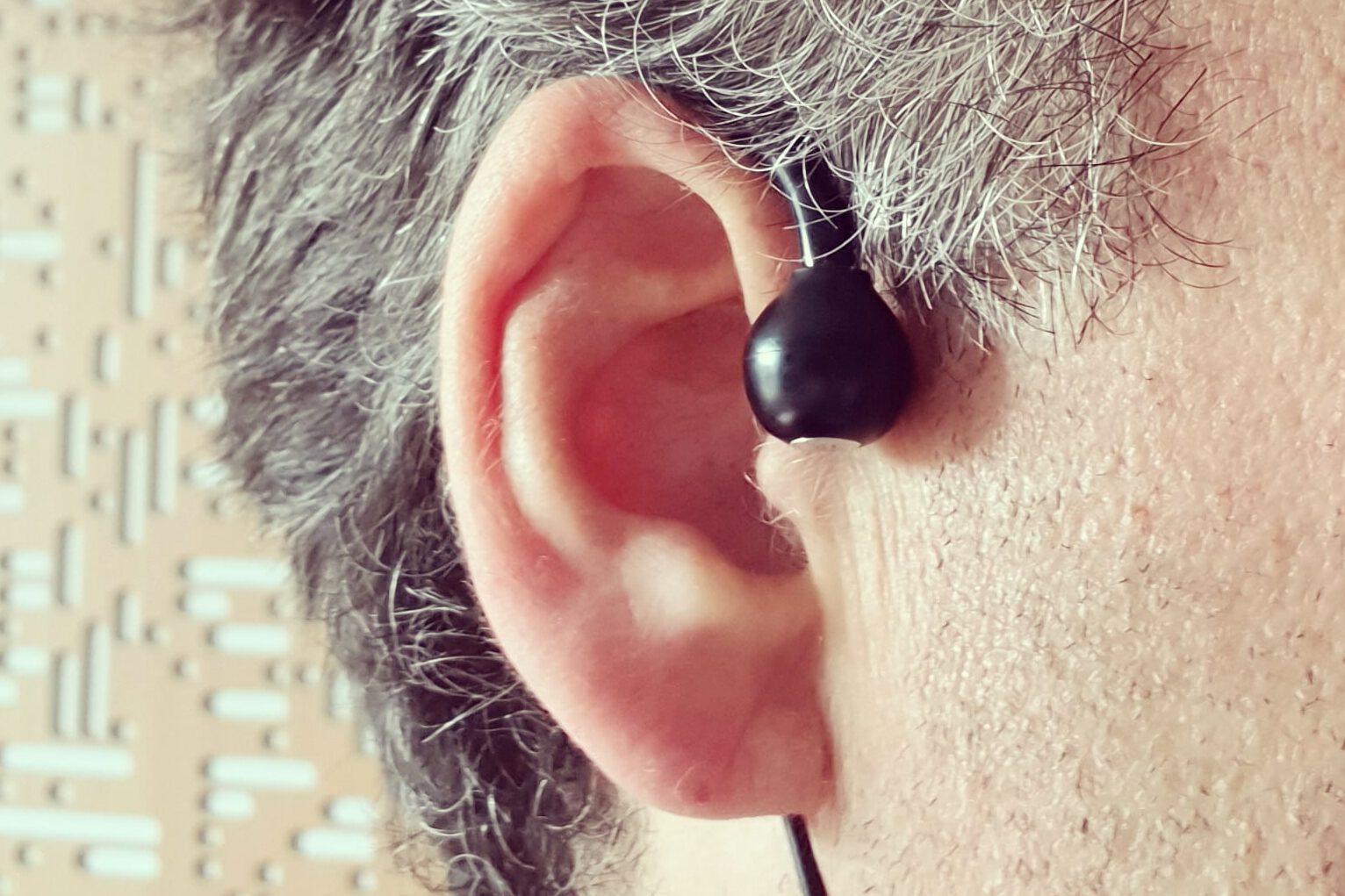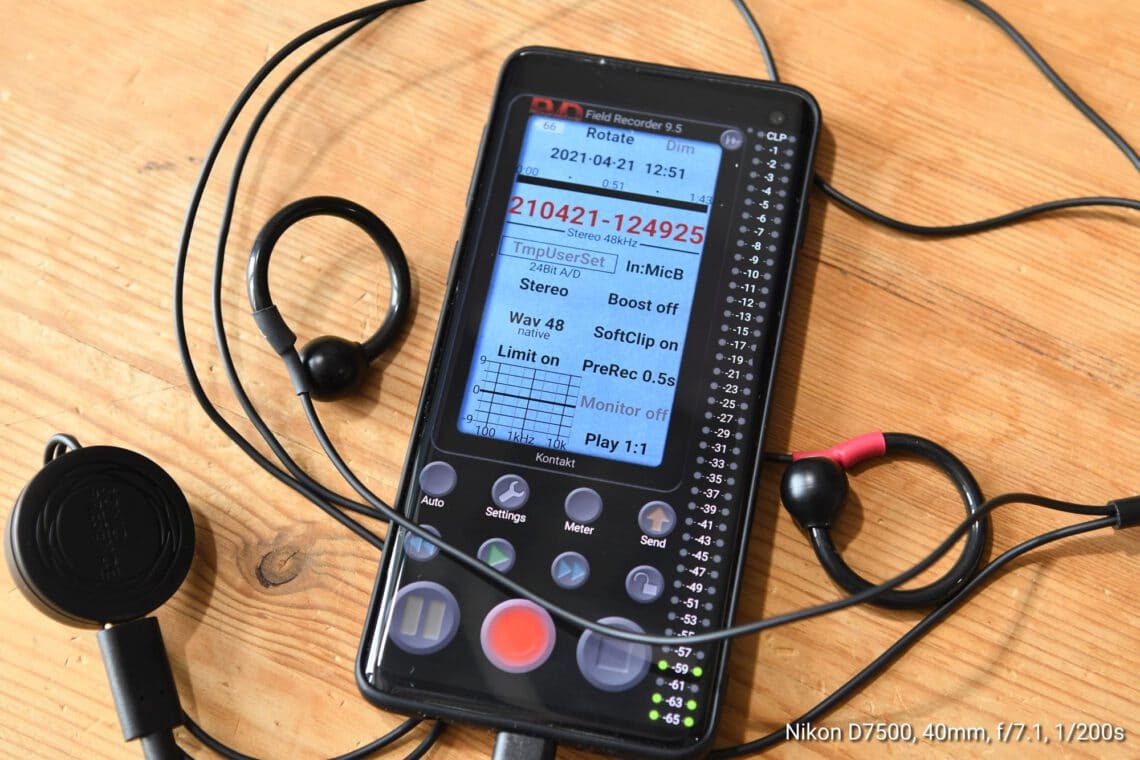The Sonic Presence SP15 microphone is worn on the ear quasi like a hearing aid and is connected directly to the smartphone or computer via USB. The arrangement acts much like an artificial head: all the functions of natural hearing and its fantastic ability to localise sounds in 360 degrees are embedded in the recordings made with it. The resulting file is incredibly realistic; it’s as if you were there!
At least that’s how Sonic Presence advertises its product, founded by Russ Hamm, a veteran of the New York pro audio scene and extremely well connected. After delivery problems from New York to Munich, audio legend Daniel Weiss of Weiss Engineering himself helped out with a copy from Zurich, which was an extremely great honour for me.
Setup
With the Fieldrecorder app for Android, for example, the complete recording setup looks like this. A setup – and this is the important thing – that you always have with you.
The capsules are not placed inside the auricle, as is the case with the artificial head or the common binaural setups with e.g. dpa mini capsules, but the capsule is worn in front of the ear (see article photo). This means that the sound is not filtered by the auricle, which may or may not reduce the spatial representation somewhat, but makes the frequency response suitable for loudspeaker reproduction. In the first example, listen to how the capsules sound inside the pinna, in the second example, how they sound in front of the ear.
Please listen to all examples and videos with headphones. Although the recordings are not broken if you listen to them through loudspeakers, the spatial effect can only be heard in all its glory through headphones.
Atmo
In the third audio sample in the playlist above, I recorded my visit to a bakery. Both I and the shop assistant were wearing a mask, so the voices are more muffled than you would expect. Especially compared to the rustling of the bags and the jingling of the coins.
The microphone connected to the smartphone can of course also be used for video recordings:
And here, unfortunately, a real weak point of this microphone becomes apparent: it is extremely sensitive even to light wind. Sadly, I have not been able to make a single usable outdoor recording. Update: The manufacturer recommends small foam windscreens for lavalier microphones, I will try them out.
Speech
The microphone is also advertised as a speaker’s microphone for the tiresome video conferencing. Here is an impressive example video from the manufacturer. Yes, it does the job very well.
Music
One of the most important applications for the SP15 is certainly the unobtrusive recording of musical performances in closed rooms. Here are a few examples from a live streamed concert. My positions correspond to realistic audience positions. If I had been able to move closer, the aesthetic quality of the sound would certainly have been even more beautiful. The SP15 has basically no problem with large dynamic ranges, but I may have gone into the limiter, as you can hear and measure. However, this could also be due to my lack of knowledge of the Filmic Pro camera app. There it looked as if there was still headroom left, but maybe that wasn’t quite true.
Unfortunately, I have come across one problem again and again: it is relatively easy to pull the USB-C plug out of my Samsung S10, or to pull it only slightly. Then, when the internal microphone is used instead of the external one, you unfortunately don’t notice it very quickly. In this case, however, it resulted in a comparison recording with the internal smartphone microphone:
Another piece in this portrait concert about the French composer Raphael Cendo, whose sound is more spatially expansive, is captured beautifully. I used Filmic Pro as the camera app because the recording level can be controlled manually. Aperture and sharpness too, and I obviously don’t have a handle on those yet either. Once again, please use headphones.
As I said, the concert was streamed live. The sound mix of the stream using classical main and support microphones can be heard comparatively here:
Fazit
As you can hear in the musical examples, the Sonic Presence SP15 allows you to make high-quality sound recordings without any effort: you always have the microphone with you, you don’t need a tripod, your smartphone serves as a recorder. It credibly captures the sound impression at the listener’s position. Most of the time, however, you would actually want a somewhat closer position than is realistically possible in a concert. But then that is a question of aesthetics.
It is a real pity that the microphone is so sensitive to wind. The microphone would be perfect for spontaneous atmospheric recordings in nature. But unfortunately it’s not usable like this. Update: The manufacturer recommends small foam windscreens like these for lavalier microphones, I will try them out.



